我们在加入中间件是这样写的:
|
1
|
app.UseStaticFiles(); |
默认是给wwwroot提供资源。
那么我访问https://localhost:44330/js/site.js 资源,就可以访问到。
|
1
2
3
4
|
// Please see documentation at https://docs.microsoft.com/aspnet/core/client-side/bundling-and-minification// for details on configuring this project to bundle and minify static web assets.// Write your JavaScript code. |
同样我们可以自定义路径。
|
1
2
3
4
|
app.UseStaticFiles(new StaticFileOptions { FileProvider = new PhysicalFileProvider(Path.Combine(env.ContentRootPath, "Static")), RequestPath="/static"}); |
上面在根目录下的static建立路由,路由路径static 为标识。
访问:
https://localhost:44330/static/images/index.jpg
就能看到一张图片了。
同样再次访问,https://localhost:44330/js/site.js 依然可以访问,看了这个wwwroot 是一个钉子户,无论如何添加还是存在的。
|
1
2
3
4
5
6
7
8
9
10
|
const string cacheMaxAge = "60480";app.UseHttpsRedirection();app.UseStaticFiles(new StaticFileOptions { FileProvider = new PhysicalFileProvider(Path.Combine(env.ContentRootPath, "Static")), RequestPath="/static", OnPrepareResponse = ctx => { ctx.Context.Response.Headers.Append("cache-control", $"public,max-age={cacheMaxAge}"); }}); |
可以设置一些缓存。
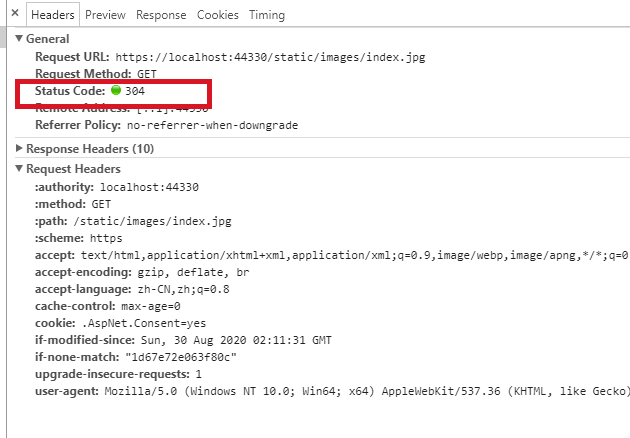
静态文件授权
官方倒是提供了两种方法。
一种是,让静态文件路由放到权限之后。
|
1
2
3
4
5
6
7
8
9
|
app.UseAuthentication();app.UseAuthorization();app.UseStaticFiles(new StaticFileOptions{ FileProvider = new PhysicalFileProvider( Path.Combine(env.ContentRootPath, "Static")), RequestPath = "/static"}); |
另一种比较自定义高:
|
1
2
3
4
5
6
7
8
|
[Authorize]public IActionResult BannerImage(){ var filePath = Path.Combine( _env.ContentRootPath, "MyStaticFiles", "images", "red-rose.jpg"); return PhysicalFile(filePath, "image/jpeg");} |
可以根据参数做一些逻辑变化。
但是这些方式比较影响性能,一般来说静态文件是开放的,而用户上传的文件是通过加密的,放在存储服务器上。
当然小型项目,可以用用。
静态文件目录
Configure中添加:
|
1
2
3
4
5
|
app.UseDirectoryBrowser(new DirectoryBrowserOptions{ FileProvider=new PhysicalFileProvider(Path.Combine(env.ContentRootPath,"Static")), RequestPath="/static"}); |
这个中间件注入的位置是应该在UseRouting之前的,同样是性能问题。
然后在ConfigureServices中添加:
|
1
|
services.AddDirectoryBrowser(); |
效果:

这种方式呢,一般只是在dev环境下打开,真正的生产环境由于安全问题就不打开的。
默认文档
|
1
2
|
app.UseDefaultFiles();app.UseStaticFiles(); |
app.UseStaticFiles(); 才是真正的路由。
app.UseDefaultFiles(); 只是说提供一些参数,比如配置下面这些为默认项。
|
1
2
3
4
|
default.htmdefault.htmlindex.htmindex.html |
其实是这样一个过程,app.UseStaticFiles() 如果没有找到相应的路由,那么应该给下一个中间件。
如果调用了app.UseDefaultFiles(),那么会去找是否存在默认项,默认是去wwwroot 下寻找上述的默认项。
默认文档可以进行修改:
|
1
2
3
4
5
|
var options = new DefaultFilesOptions();options.DefaultFileNames.Clear();options.DefaultFileNames.Add("mydefault.html");app.UseDefaultFiles(options);app.UseStaticFiles(); |
UseFileServer 结合了 UseStaticFiles、UseDefaultFiles 和 UseDirectoryBrowser(可选)的功能。
app.UseFileServer(enableDirectoryBrowsing: true);
enableDirectoryBrowsing 表示是否使用UseDirectoryBrowser。
FileExtensionContentTypeProvider
FileExtensionContentTypeProvider 类包含 Mappings 属性,用作文件扩展名到 MIME 内容类型的映射。
比如说我去访问:https://localhost:44330/static/test.myapp
我在static 下有test.mapp 这个文件,但是静态文件处理并没有去处理。
原因:
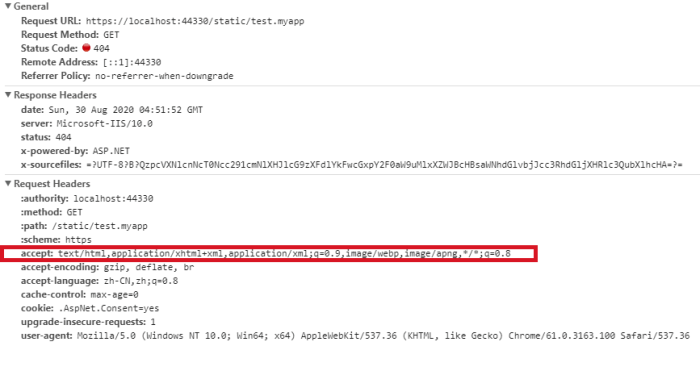
客服端发了这样一个请求,人家接受这些流,但是服务器找到到,myapp 对应的媒体类型,那么这个时候客户端就不会接受了,服务端也认为没有找到。
官方给了例子:
|
1
2
3
4
5
6
7
8
9
10
11
12
13
14
15
16
17
18
19
20
21
|
var provider = new FileExtensionContentTypeProvider();// Add new mappingsprovider.Mappings[".myapp"] = "application/x-msdownload";provider.Mappings[".htm3"] = "text/html";provider.Mappings[".image"] = "image/png";// Replace an existing mappingprovider.Mappings[".rtf"] = "application/x-msdownload";// Remove MP4 videos.provider.Mappings.Remove(".mp4");app.UseDefaultFiles();app.UseStaticFiles();app.UseStaticFiles(new StaticFileOptions{ FileProvider = new PhysicalFileProvider(Path.Combine(env.ContentRootPath, "Static")), RequestPath = "/static", OnPrepareResponse = ctx => { ctx.Context.Response.Headers.Append("cache-control", $"public,max-age={cacheMaxAge}"); }, ContentTypeProvider= provider} |
给他加一个媒体类型,认为myapp 应该是一个需要下载文件。
然后运行之,然后就会出现下载。
同样,我们写的是.html,如果我们不喜欢可以去写.htm3也行。
https://localhost:44330/static/index.htm3
结果:
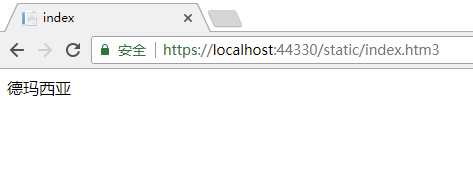
因为provider.Mappings[".htm3"] = "text/html"; ,.htm3被映射成了text/html,那么客户端就按照这种格式处理。所以模板引擎就可以多样性,有兴趣自己也可以去设计。
这就是媒体类型映射。
如果是媒体类型未知的情况下,那么可以这样:
|
1
2
3
4
5
6
7
8
9
10
11
|
app.UseStaticFiles(new StaticFileOptions{ FileProvider = new PhysicalFileProvider(Path.Combine(env.ContentRootPath, "Static")), RequestPath = "/static", OnPrepareResponse = ctx => { ctx.Context.Response.Headers.Append("cache-control", $"public,max-age={cacheMaxAge}"); }, DefaultContentType = "image/png"}); |
ServeUnknownFileTypes true
DefaultContentType “image/png” 让客户端按照图片处理。

但是官方给了建议。
启用 ServeUnknownFileTypes 会形成安全隐患。 它默认处于禁用状态,不建议使用。
FileExtensionContentTypeProvider 提供了更安全的替代方法来提供含非标准扩展名的文件。
联系信息:邮箱aoxolcom@163.com或见网站底部。



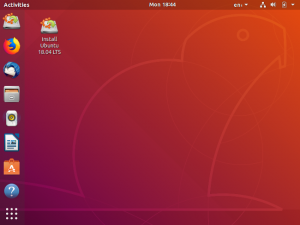



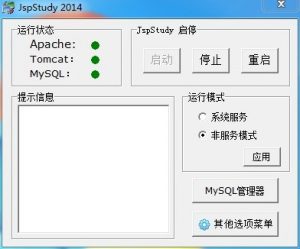
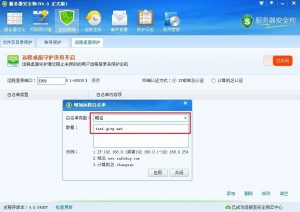



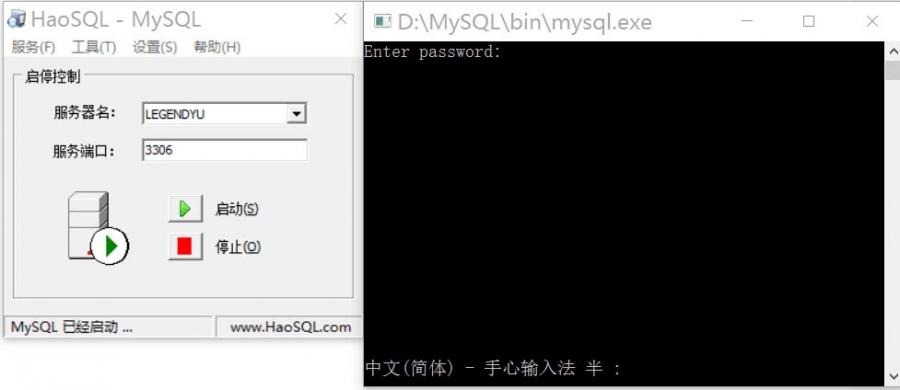


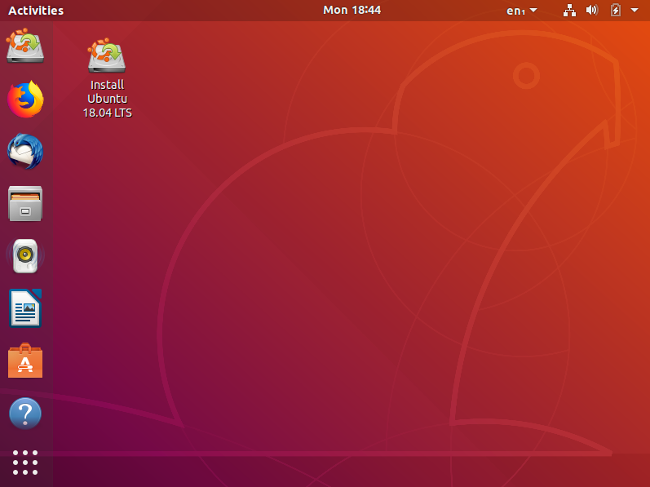



请登录后发表评论
注册
社交帐号登录